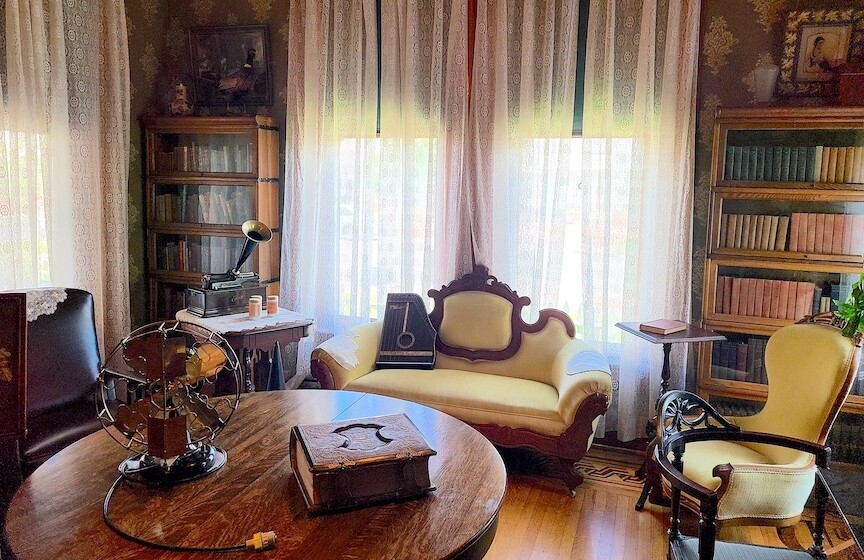Family Parlor
 In her interview with Heritage Square, Jessie Jean (Higley) Lane recalled that her family used this room as their dining room. The family had a buzzer in the floor which would ring in the kitchen to summon the domestic help. She also remembered that the family’s domestic help bemoaned the long distance between their dining room and the kitchen. Based on this information, the room was exhibited as the dining room when Rosson House first opened to the public as a museum. In 1984, the room was converted to a library/parlor.
In her interview with Heritage Square, Jessie Jean (Higley) Lane recalled that her family used this room as their dining room. The family had a buzzer in the floor which would ring in the kitchen to summon the domestic help. She also remembered that the family’s domestic help bemoaned the long distance between their dining room and the kitchen. Based on this information, the room was exhibited as the dining room when Rosson House first opened to the public as a museum. In 1984, the room was converted to a library/parlor.
Georgia (Gammel) Valliere recollected in her interview that this room served as a shared bedroom for her and her two sisters, Annie and Wilma (the upstairs rooms were rented out to boarders). She also recalled that the room had a plate rack and a bell in the floor, which were installed before the Gammel family moved into the Rosson House.
When the City purchased the home in the 1970s, this room had been split in half and sinks were added to the rooms for the boarders’ use. The vertical sliding door had been closed off, and a secondary, lower ceiling had been added.
There are a few interesting artifacts in this room that visitors want to know more about. Here are a few of our favorites, in alphabetical order (if there are any we’ve missed that you’d like to know more about, please let us know):
-
Bible
 A large family Bible with tooled leather and gilt decorations. Sides have two clasps. Family information includes marriage, birth, death records and photos. It also has space for a Temperance Pledge, which is not filled out. This Bible was purchased in 1885 by the Schmitt family, and they donated it to Heritage Square just over a century later.
A large family Bible with tooled leather and gilt decorations. Sides have two clasps. Family information includes marriage, birth, death records and photos. It also has space for a Temperance Pledge, which is not filled out. This Bible was purchased in 1885 by the Schmitt family, and they donated it to Heritage Square just over a century later. -
Edison Phonograph
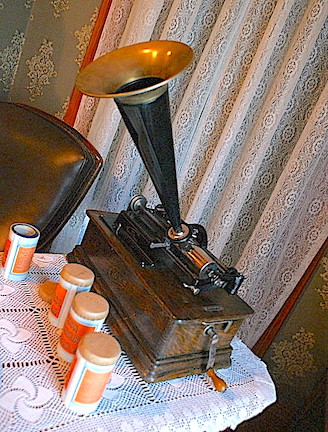 An Edison Home Phonograph, circa 1906. It is a cylinder-type hand-operated phonograph with the body and case made from oak. Some phonographs came with a bigger cone for a louder sound, and some even had early headphones, called hearing tubes, which listeners could plug into the phonograph to listen to music privately. Phonographs that played cylinders predated those that played flat records by about a decade.
An Edison Home Phonograph, circa 1906. It is a cylinder-type hand-operated phonograph with the body and case made from oak. Some phonographs came with a bigger cone for a louder sound, and some even had early headphones, called hearing tubes, which listeners could plug into the phonograph to listen to music privately. Phonographs that played cylinders predated those that played flat records by about a decade. -
Electric Fan
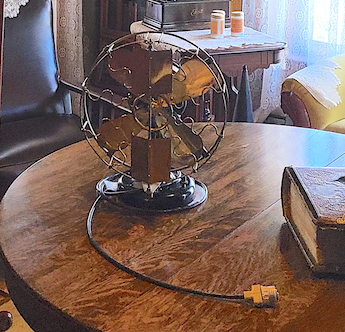 An Electric Westinghouse brand fan, circa 1906. The base and casing of motor are iron and are painted a glossy black, and the blades and cover are brass. The front of the fan blade cover has two brass flaps used for directing the air. The base has an on/off switch and may have had a multiple speed button as well.
An Electric Westinghouse brand fan, circa 1906. The base and casing of motor are iron and are painted a glossy black, and the blades and cover are brass. The front of the fan blade cover has two brass flaps used for directing the air. The base has an on/off switch and may have had a multiple speed button as well. -
Piano
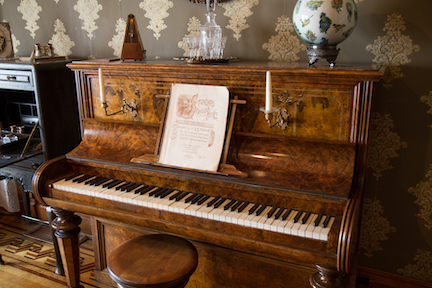 An upright piano, circa 1824, manufactured by Collard and Collard, London. The piano is made from burl walnut with incised veneer and gilt decorations. There are movable brass candle holders on either side of front panel for the person playing the piano to be able to see their sheet music after dark.
An upright piano, circa 1824, manufactured by Collard and Collard, London. The piano is made from burl walnut with incised veneer and gilt decorations. There are movable brass candle holders on either side of front panel for the person playing the piano to be able to see their sheet music after dark. -
Potichomanie Ball
 A glass potichomanie ball seated on a silver plated stand. Potichomania refers to the art of imitating painted porcelain ware. Potichomanie balls, also known as memory balls, witch’s balls, or Victorian whimsies, are created with a process similar to decoupage – printed paper motifs are cut out and glued on the inside of a clear glass ball. Paint would be applied on the inside of the ball after the glue was dry to create a finished piece that looked like painted china.
A glass potichomanie ball seated on a silver plated stand. Potichomania refers to the art of imitating painted porcelain ware. Potichomanie balls, also known as memory balls, witch’s balls, or Victorian whimsies, are created with a process similar to decoupage – printed paper motifs are cut out and glued on the inside of a clear glass ball. Paint would be applied on the inside of the ball after the glue was dry to create a finished piece that looked like painted china. -
Writing Set
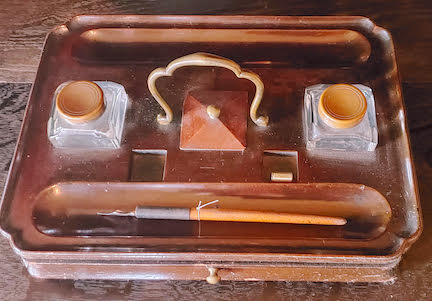 A wooden writing set with a drawer in the front for keeping paper/letters, two glass ink bottles with lids, an indention for pens and a separate indention with a lid for pen nibs. This desk set belonged to Whitelaw Reid – editor of the New York Times, Ambassador to France and later to England, and one-time Vice Presidential candidate – who rented Rosson House from the Rosson family for two winters.
A wooden writing set with a drawer in the front for keeping paper/letters, two glass ink bottles with lids, an indention for pens and a separate indention with a lid for pen nibs. This desk set belonged to Whitelaw Reid – editor of the New York Times, Ambassador to France and later to England, and one-time Vice Presidential candidate – who rented Rosson House from the Rosson family for two winters.
Explore the history of ordering household items through mail-order by reading our blog article, Mail-Order Catalogues. Learn more about the musical instruments in this room from our blog article, Making Music, and about the lovely print hanging above the piano in this room from our article, Printed Not Painted. Find out more about Whitelaw Reid and his stay at Rosson House from our article, High Society at Heritage Square.
La Sala Familiar
 En su entrevista con Heritage Square, Jessie Jean (Higley) Lane recuerda que su familia utilizó este cuarto como su comedor. La familia tenía un timbre en el piso el cual sonaría en la cocina para llamar a sus empleados domésticos. También recordó que a los empleados domésticos lamentaban la larga distancia de su comedor a la cocina. Basado en esta información, el cuarto se exhibió como comedor cuando la Casa Rosson se abrió por primera vez al público como museo. En 1984, el cuarto se convirtió en una biblioteca/sala.
En su entrevista con Heritage Square, Jessie Jean (Higley) Lane recuerda que su familia utilizó este cuarto como su comedor. La familia tenía un timbre en el piso el cual sonaría en la cocina para llamar a sus empleados domésticos. También recordó que a los empleados domésticos lamentaban la larga distancia de su comedor a la cocina. Basado en esta información, el cuarto se exhibió como comedor cuando la Casa Rosson se abrió por primera vez al público como museo. En 1984, el cuarto se convirtió en una biblioteca/sala.
Georgia (Gammel) Valliere recordó en su entrevista que esta habitación servía como dormitorio para ella y sus dos hermanas, Annie y Wilma (las habitaciones de arriba se alquilaban a huéspedes.) También recordó que la habitación tenía un estante para platos y un timbre en el piso que se instalaron antes que la familia Gammel se mudara a la Casa Rosson.
Cuando la ciudad adquirió la casa en los 1970s, este cuarto se había dividido a la mitad y se habían agregado lavabos a las habitaciones para el uso de los huéspedes. La puerta corrediza vertical se había bloqueado, y un segundo techo más bajo se le añadió.
Hay algunos artefactos interesantes en esta habitación de los cuales los visitantes quisieran saber más. Aquí están algunos de nuestros favoritos, en orden alfabético (si hay alguno que ha faltado del cual quisieras saber más, háznoslo saber):
-
Biblia
 Gran Biblia familiar con cuero repujado y adornos dorados. Los lados tienen dos cierres. La información familiar incluye registros de matrimonio, nacimiento, defunción y fotografías. Esta Biblia se adquirió en 1885 por la familia Schmitt y la donaron a Heritage Square poco más de un siglo después.
Gran Biblia familiar con cuero repujado y adornos dorados. Los lados tienen dos cierres. La información familiar incluye registros de matrimonio, nacimiento, defunción y fotografías. Esta Biblia se adquirió en 1885 por la familia Schmitt y la donaron a Heritage Square poco más de un siglo después. -
Bola de Potichomanie
 Una bola de potichomanie de vidrio sobre un soporte plateado. Potichomania se refiere al arte de imitar la porcelana pintada. Las bolas de Potichomanie, también conocidas como bolas de memoria, bolas de bruja, o caprichos victorianos, se crean con un proceso similar al decoupage – las imágenes de papel impreso se recortan. Y pegan en el interior de una bola de vidrio transparente. La pintura se aplicaría en el interior de la bola después de que el pegamento se secara para crear una pieza terminada que pareciera porcelana pintada.
Una bola de potichomanie de vidrio sobre un soporte plateado. Potichomania se refiere al arte de imitar la porcelana pintada. Las bolas de Potichomanie, también conocidas como bolas de memoria, bolas de bruja, o caprichos victorianos, se crean con un proceso similar al decoupage – las imágenes de papel impreso se recortan. Y pegan en el interior de una bola de vidrio transparente. La pintura se aplicaría en el interior de la bola después de que el pegamento se secara para crear una pieza terminada que pareciera porcelana pintada. -
Escritorio
 Escritorio de madera con un cajón en la parte delantera para guardar papeles/cartas, dos frascos de tinta con tapas, una hendidura para colocar plumas y otra hendidura con tapa para plumillas. Este escritorio perteneció a Whitelaw Reid – editor del New York Times, embajador a Francia y después Inglaterra, y ex-candidato a la vicepresidencia – quien alquiló la Casa Rosson de la familia Rosson por dos inviernos.
Escritorio de madera con un cajón en la parte delantera para guardar papeles/cartas, dos frascos de tinta con tapas, una hendidura para colocar plumas y otra hendidura con tapa para plumillas. Este escritorio perteneció a Whitelaw Reid – editor del New York Times, embajador a Francia y después Inglaterra, y ex-candidato a la vicepresidencia – quien alquiló la Casa Rosson de la familia Rosson por dos inviernos. -
Fonógrafo Edison
 Un fonógrafo casero de Edison de alrededor de 1906. Es un fonógrafo manual de cilindros con su cuerpo y caja hechos de roble. Algunos fonógrafos incluían un cono más grande para un sonido más fuerte, y algunos incluso tenían audífonos antiguos, llamados tubos auditivos, que los oyentes podían conectar al fonógrafo para escuchar música en privado. Los fonógrafos que tocaban cilindros eran anteriores a aquellos que tocaban discos planos por alrededor de una década.
Un fonógrafo casero de Edison de alrededor de 1906. Es un fonógrafo manual de cilindros con su cuerpo y caja hechos de roble. Algunos fonógrafos incluían un cono más grande para un sonido más fuerte, y algunos incluso tenían audífonos antiguos, llamados tubos auditivos, que los oyentes podían conectar al fonógrafo para escuchar música en privado. Los fonógrafos que tocaban cilindros eran anteriores a aquellos que tocaban discos planos por alrededor de una década. -
Ventilador Eléctrico
 Ventilador eléctrico de la marca Westinghouse de alrededor de 1906. La base y cubierta del motor son de hierro y están pintados de negro brillante, y las aspas y cubierta son de latón. El frente de la cubierta de las aspas del ventilador tiene dos aletas de latón que se utilizan para dirigir el aire. La base tiene un interruptor de encendido/apagado y también pudo haber tenido un botón de múltiples velocidades.
Ventilador eléctrico de la marca Westinghouse de alrededor de 1906. La base y cubierta del motor son de hierro y están pintados de negro brillante, y las aspas y cubierta son de latón. El frente de la cubierta de las aspas del ventilador tiene dos aletas de latón que se utilizan para dirigir el aire. La base tiene un interruptor de encendido/apagado y también pudo haber tenido un botón de múltiples velocidades. -
Piano
 Piano vertical, de alrededor de 1824, fabricado por Collard y Collard, Londres. El piano está hecho de nogal burl con incisiones y decoraciones doradas. Cuenta con candelabros de latón a cada lado del panel frontal para que la persona tocando el piano pudiera ver sus partituras al oscurecer.
Piano vertical, de alrededor de 1824, fabricado por Collard y Collard, Londres. El piano está hecho de nogal burl con incisiones y decoraciones doradas. Cuenta con candelabros de latón a cada lado del panel frontal para que la persona tocando el piano pudiera ver sus partituras al oscurecer.
Explora la historia de los pedidos por correo de artículas para el hogar de nuestro artículo de blog, Catálogos de órdenes por correo. Aprende acerca de los instrumentos musicales en esta habitación con nuestro artículo “Creando música”, y acerca del bello grabado sobre el piano de esta habitación con nuestro artículo “Impreso, no pintado”. Descubre más acerca de Whitelaw Reid y su estadía en la Casa Rosson con nuestro artículo, Alta Sociedad en Heritage Square.
Siguiente Página: Cocina Y Alacena Volver a la Página Principal
